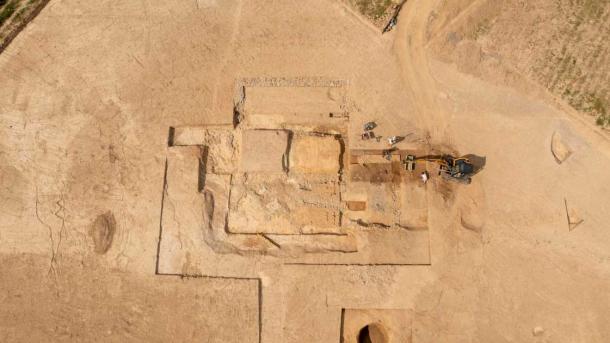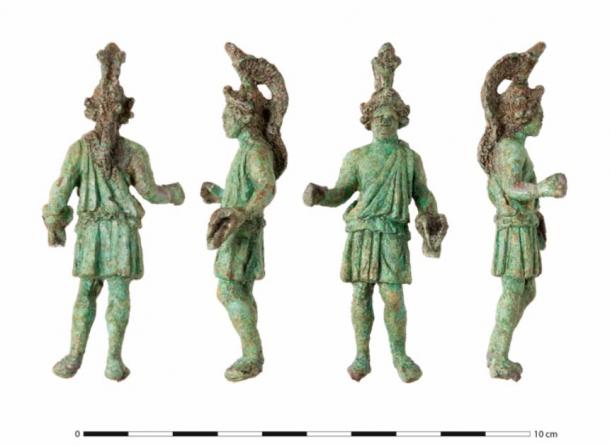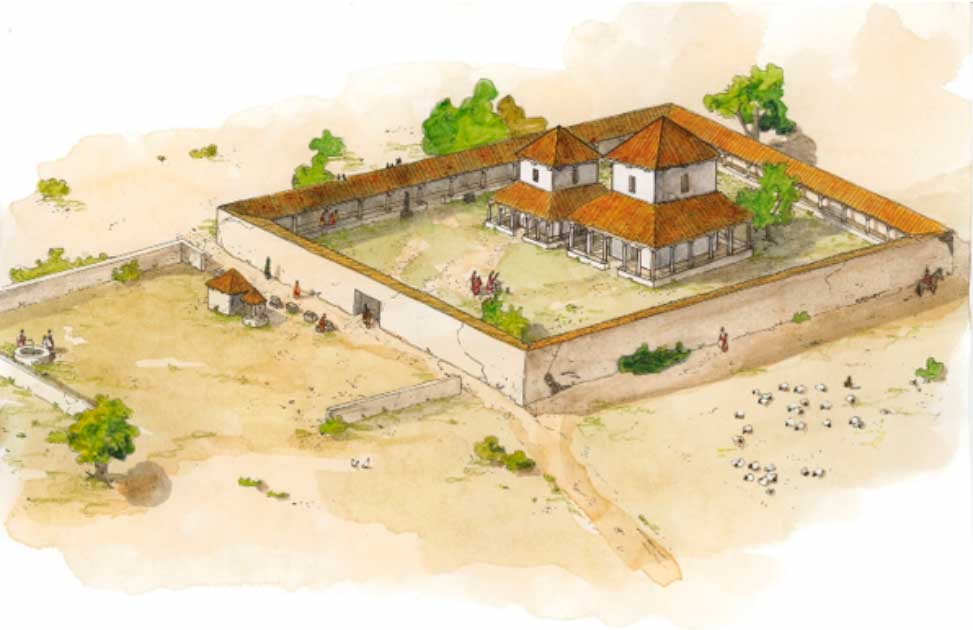Gallo-Roman Worship Complex Dedicated to Jupiter and Mars Discovered
Last week, French archaeologists found the long-lost remains of a 2,100-year-old Gallo-Roman worship complex in Rennes, Brittany (northwestern France) on a hilltop with sweeping views of the Flume valley. The Rennes Gallo-Roman religious center was built right after the Roman conquest of the tribes of Gaul in France in the 1st century BC. The Flume valley Gallo-Roman religious site was huge and home to two temples, one was probably dedicated to the Roman god Mars. So far many metal artifacts have been found at the site as well as the remains of the two temple structures, and a bathhouse.
According to the evidence unearthed by French archaeologists, the Rennes Gallo-Roman complex continued to function as a religious center until the 4th century AD. This date marks the fall of the Western Roman Empire and the rise of Christianity as a religious organization that replaced Roman religious practices in Rome and in also in Gaulish France.
The site had been slated for development, leading to a preventative archaeology excavation of over seven hectares (17.3 acres) of the site. The find was made by Inrap (National Institute for Preventive Archaeological Research) archaeologists, who’d begun excavations in March 2022 at the Brittany site. As per a press release on the Inrap website, this ancient sacred place “offers a dive into the daily life of an important Gallo-Roman place of worship.”

An aerial view of the Gallo-Roman religious complex found at Rennes in northwestern France, which was home to two temples, a bathing area, and columned galleries on two sides. (Emmanuelle Collado / INRAP)
Rennes’ Gallo-Roman Site Was A Gaulish Reflection of Rome
The Inrap experts were amazed by the architectural organization and evidence of social constructs identified within the Rennes’ Gallo-Roman complex. This Roman-era worship site was a center of ancient public life that was considered “essential.” Importantly, it helps us further understand how the local Celtic populations integrated with Roman religion, order, and social practices, particularly the Gaulish Riedones tribe.
The Riedones were a Celtic Gallic tribe dwelling in Brittany (northwestern France and the extended region), and their capital was the ancient settlement of Codante, which is now part of the city of Rennes.
The importance of the Riedones tribe’s chief town is seen in its strategic positioning. The western side looks over the Flume valley, and just to east lies the Rennes river basin. To the north of Codante lay the great Roman road that connected Rennes and Corseul, another Gallo-Roman center in the Brittany region, which was founded in 10 BC.
- How A Roman Sacred Site Became A 300-AD Tile And Brick Factory
- Valeria: Thriving Roman Holiday Resort Emerging From Abandoned Ruins
Rome was the first major historical empire that made religion part of daily life throughout their empire. Romans were polytheistic and had a large pantheon of gods and goddesses, and Hellenistic religious ideas continued to have a major influence in the lives of Roman elites. However, in the first centuries after the birth of Jesus, Rome became the new home for a strong, new monotheistic worldview.
Rome endured nearly 300 years of vociferous opposition and violence against the doctrines of Christianity. The Roman elites viewed the Christians as irreligious, superstitious, and a threat to the established social order of the empire. Christianity was seen as a force that empowered the dispossessed and weak. This prompted a huge pushback from the Roman elites, who saw Christianity as a foreign cult.
In the first few centuries of the new Christian period in Rome, several emperors advocated state policies that encouraged the worship of the traditional Roman gods and persecuted those who did worshipped other gods.

This figure of Mars, shown from all sides, was found at the Rennes’ Gallo-Roman religious center, and was likely worshiped in one of the two temples in the complex. (© Emmanuelle Collado / Inrap)
The Evidence Found at the Brittany Gallo-Roman Complex
The Rennes Gallo-Roman sanctum showed considerable evidence that the Roman god of war, Mars, and Jupiter (the Roman counterpart to the Greek god of the sky, Zeus) were worshipped here.
The large Gallo-Roman sanctuary, consisting of a 60-meter (197-foot) columned gallery on two sides was home to two temples, one bigger than the other. Both were square masonry temples with a central cella inside a square gallery. A cella is a box-like structure functioning as the inner chamber of an ancient Greek or Roman temple in the classical antiquity period (8th centuryBC-6th century AD).
The Rennes’ complex follows a layout that is typical of the Romano-Celtic fanum style, reports Arkeonews. The Romano-Celtic style dates to the late Iron Age. In these temples, a cult figure of the worshipped deity would reside in the cella. The faithful offered their prayers, sacrifices, and devotion before the temple in the columned gallery area.
The large temple was dedicated to the primary deity (or a group of deities), while the smaller was dedicated to a hierarchically inferior (or smaller) deity. The lead deity is called the tutelary deity and the smaller deity is called the secondary deity.
The small bronze statuette of Mars found at the Rennes site suggests that one of the temples was dedicated to this god. However, for the local Gauls Mars was not a fiery war god but a protective, benevolent figure, who provided important guidance and help in the arts of healing and health.
Associations to the Roman god Jupiter were also found at the site including an exceptional bronze vessel decorated with Jupiter themes. It has an eagle and lightning bolt figure on both handles, a nod to the Jupiter’s powers. One handle depicts the face of Cupid (the Roman deity of erotic love), who is represented as a naked boy holding a bow and arrow. In the Rennes bronze vessel, Cupid is symbolized by the two wings present on either side of an angelic face. Both handles were decorated with an eagle and several stylized thunderbolts, which are Jupiter symbols.

This remarkable bronze cup found at the Rennes’ Gallo-Roman complex is dedicated to Jupiter. It has an eagle and thunderbolt on both handles and a reference to Cupid on the (left) handle. (© Emmanuelle Collado / Inrap)
Other Discoveries and the End of the Cult
The excavation also unearthed a thermal bath building, covering 120 square meters (1,292 square feet). These baths were symbolic of the “Roman way of life,” and probably intended for public use for worshippers at the sanctuary. Some architectural remains, along with broken painted fragments, an underfloor hypocaust heating system, and remains of washing basins were found in this part of the Rennes’ Gallo-Roman complex.
- How Gaul ‘Barbarians’ Influenced Ancient Roman Religion
- Neo-Romans Revive Classical Worship Ceremonies at New Iuppiter Perunus Temple
Finally, the excavation revealed the discarded objects and offerings from worshippers, including ornaments, monetary offerings, and urns. The urns were dated to the beginning of the Iron Age (500-400 BC), which showed that the complex had been in constant use for centuries. The cult was likely abandoned at the end of the 2nd century AD, reports Archaeology News Network.
“What interests us about an excavation like this is to understand the origin of our countryside, to collect information on the way of life, the social organization in the countryside, the patterns of the roads, the plots to restore the organization of the north of the Rennes basin in Roman times,” said Bastien Simier, scientific manager at the site. The site will be open to the public on June 17, 18, and 19 to mark the European Archaeology Days, coordinated by the National Institute for Preventive Archaeological Research (Inrap).
Top image: An artist’s recreation of the Gallo-Roman religious complex recently discovered at Rennes, France. Source: © Marie Millet / Inrap
By Sahir Pandey
References
Altuntaş, L. 2022. An important Gallo-Roman worship complex was discovered near Rennes, France. Available at: https://arkeonews.net/an-important-gallo-roman-worship-complex-was-discovered-near-rennes-france/.
ANN. 2022. Gallo-Roman Sanctuary Discovered In North-Western France. Available at: https://archaeologynewsnetwork.blogspot.com/2021/06/gallo-roman-sanctuary-discovered-in.html.
INRAP. 2022. UN REMARQUABLE ENSEMBLE CULTUEL GALLO-ROMAIN À LA CHAPELLE-DES-FOUGERETZ (ILLE-ET-VILAINE). Available at: https://www.inrap.fr/un-remarquable-ensemble-cultuel-gallo-romain-la-chapelle-des-fougeretz-ille-et-16529.



















